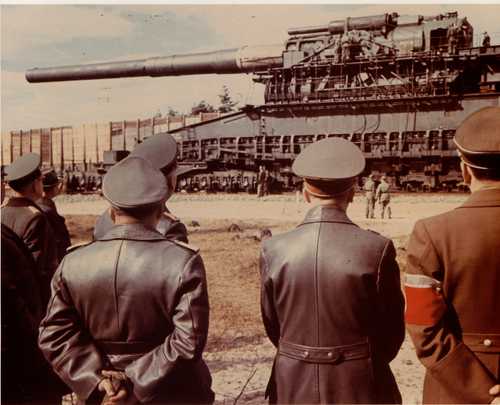
German Artillery
Schwere Gustav
Hitler, Speer, Bormann and Heer officers view superheavy railway gun "Gustav" (named after the late Gustav Krupp). This photo was probably taken at the gun's official handing over for trials at the Rugenwalde Proving Grounds early in 1941. "Gustav", and his sister, "Dora", were the ultimate product of a German War Ministry commission to Krupp of Essen dating from 1934. The requirement was to produce guns capable of destroying the fortifications of France's nascent Maginot line. Krupp's designers did not do things by halves in this case. The eventual product was a 1,350 metric ton, 800mm long-barreled cannon, capable of firing bunker-busting and high-explosive ammunition (with rocket projectiles envisaged), mounted on a special 47-metre railway gun-carriage running on double railway tracks. The gun had no traversing capacity (not unusual for heavy railway guns) - special curving spur lines had to be laid on site to allow the gun to be aimed in the horizontal. The price per gun was an eye-watering 7 million RM. As was their tradition, Krupp did not charge for the first gun delivered; they did charge for the second, "Dora". Due to initial delays (hardly viewed as an immediate priority of rearmament), "Gustav" obviously missed his date with the Maginot Line (not that this mattered, anyway). Sebastopol was less fortunate than the Maginot Line, as it "hosted" the 80cm gun's first and only action. Mind you, "Gustav" was not Sebastopol's only problem - Manstein poured so much artillery fire of all sorts into the city that little was left intact when it fell. However, it did demonstrate its destructive power. Between 5 and 17 June, 1942, "Gustav" fired 48 shells. In the process, it destroyed a number of fortifications an underwater bunker-arsenal, and at least one ship. That, however, was it. Having fired a total of some 300 shells (including proving), "Gustav's" barrel was shot-out, and had to be returned to Krupp for relining. The gun was subsequently moved up to bombard Leningrad, but was never used. "Gustav's" sister, "Dora" was even less fortunate. She was moved up to support German forces at Stalingrad but, by the time she was ready to fire (a process that took 250 men three days, including specialist railway track-laying), she had to be withdrawn without firing a shot due to the threat of capture by the Soviets. She was never deployed again. Both she and "Gustav" were destroyed before the end of the war to prevent capture. Some may argue that the "Royal Tiger" was not a waste of time and money; some may even argue that the "Maus" tank would have been worth the effort. Notwithstanding some spectacular results at Sebastopol, however, I cannot see any way of arguing that this monster was not a waste of time, money, metal and considerable intellectual effort and ingenuity on the part of Krupp's designers, engineers and workers. Best regards, JR.
18005 Views
6/2/2008
